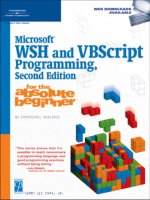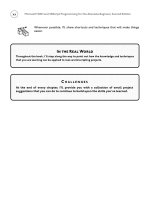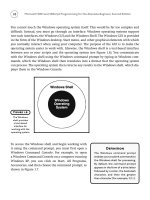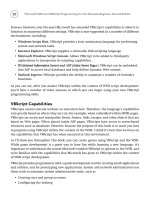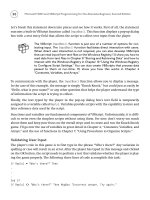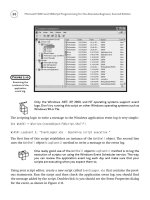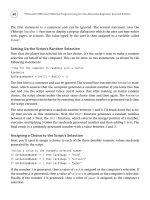Microsoft WSH and VBScript Programming for the Absolute Beginner Part 14 pps
Bạn đang xem bản rút gọn của tài liệu. Xem và tải ngay bản đầy đủ của tài liệu tại đây (378.95 KB, 10 trang )
110
Microsoft WSH and VBScript Programming for the Absolute Beginner, Second Edition
StoryMsg = “Once upon a time there were 3 little pigs” & vbCrLf & _
“who liked to build things.” & vbCrLf & vbCrLf & _
vbTab & “The End”
‘Display the story to the user
MsgBox StoryMsg, vbOkOnly + vbExclamation, cTitleBarMsg
The text message that is displayed by the script is
Once upon a time there were 3 little pigs who liked to build things.
The End
Notice how the vbCrLf and vbTab constants have been placed throughout the text to specify
how VBScript should display message text. Figure 4.9 shows the output that is displayed
when this script is executed.
If the
vbCrLf and vbTab constants were removed from the formatted message, the text dis-
played in the pop-up dialog would look completely different, as shown in Figure 4.10.
Figure 4.9
Using VBScript
string constants
to manipulate the
display of text in
pop-up dialogs.
Figure 4.10
Displaying the
same output as
the previous
example without
the use of the
vbCrLf and
vbTab constants.
For more information about VBScript constants, go to and
click on the VBScript Documentation link.
Storing Data That Changes During Script Execution
Chances are most programs that you write will have data in them that will need to be mod-
ified. For example, you may write a script that asks the user for input and then modifies the
data while processing it. In this situation, you can define variables.
Two categories of variables are available to your scripts: variables that you define within your
scripts and environment variables that are maintained by Windows that your scripts can refer-
ence. I’ll demonstrate how to work with both categories of variables in the sections that follow.
VBScript Data Types
Unlike many other programming languages, VBScript
only supports one type of variable, called a variant.
However, a variant is very flexible and can be used to
store a number of different types of data. Table 4.4 lists
variant data types supported by VBScript.
111
Chapter 4 • Constants, Variables, and Arrays
Definition
A variant is a type of variable that
can contain any number of different
types of data.
Subtype Description
Boolean A variant with a value of True or False
Byte An integer whose value is between 0 and 255
Currency A currency value between –922,337,203,685,477.5808 and 922,337,203,685,477.5807
Date A number representing a date between January 1, 100 and December 31, 9999
Double A floating-point number with a range of –1.79769313486232E308 and
–4.94065645841247E-324 or 4.94065645841247E-324 and 1.79769313486232E308
Empty A variant that has not been initialized
Error A VBScript error number
Integer An integer with a value that is between –32,768 and 32,767
Long An integer whose value is between –2,147,483,648 and 2,147,483,647
Null A variant set equal to a null value
Object An object
Single A floating-point number whose value is between –3.402823E38 and –1.401298E-45
or 1.401298E-45 and 3.402823E38
String A string up to two billion characters long
TABLE 4.4 VBSCRIPT SUPPORTED VARIANT S UBTYPES
112
Variants automatically recognize the types of data that are assigned to them and act accord-
ingly. In other words, if a date value is assigned to a variant, then your script can use any of
VBScript’s built-in date functions to work with it. Likewise, if a text string is assigned to a
variant, then your script can use any of VBScript’s built-in string functions to work with it.
Like constants, VBScript provides you with some control over the way in which it identifies
the types of values stored in a variant. For example, if you assign 100 as the variable value,
then VBScript automatically interprets this value as a number. But if you enclose the value
in quotation marks, VBScript treats it like a string.
VBScript also provides the capability to convert data
from one type to another using built-in VBScript func-
tions. You can use these functions within your scripts
to change the way VBScript views and works with data.
For example, the following VBScript statement defines
a variable named
MyBirthday and assigns it a text string
of
“November 20, 1964”:
MyBirthday = “November 20, 1964”
VBScript views this variable’s value as a text string. However, using the Cdate() function, you
can covert the string value to date format:
MyBirthday = CDate(MyBirthday)
Now, instead of seeing the variable’s value as “November 20, 1964”, VBScript sees it as
11/20/1964.
VBScript provides a large number of conversion functions that you can use to
convert from one data type to another. These functions include Asc(), Cbool(),
Cbyte(), Cbur(), Cdate(), CDbl(), Chr(), Cint(), CLng(), CSng(), and CStr(). For
more information about how to use these functions, see Chapter 7.
Defining Variables
VBScript provides two ways of defining variables: dynamically, and formally, using the Dim
statement. To dynamically create a variable within a script, you simply need to reference it
like this:
MyBirthday = #November 20, 1964#
HINT
Microsoft WSH and VBScript Programming for the Absolute Beginner, Second Edition
Definition
The term string and text string are
used synonymously throughout
this book to refer to text-based
data or other types of data that
have been enclosed within a pair of
quotations.
Using this method of programming, you can define variables anywhere within your script.
However, I strongly recommend against creating variables in this manner. It is much better
to formally define any variables used in a script all at once at the beginning of the script.
This helps keep things organized and easier to read. In addition, I also strongly suggest that
you use the
Dim statement. The syntax of the Dim statement is as follows:
Dim VariableName
VariableName
is the name of the variable being defined. For example, the following state-
ment defines a variable named
MyBirthday:
Dim MyBirthday
After a variable has been defined, you can assign a value to it, like this:
MyBirthday = #November 20, 1964#
Always use the Dim statement to make your code more readable and to explicitly show your
intentions. You can define multiple variables within your scripts using multiple
Dim statements:
Dim MyBirthday
Dim MyName
Dim MyAge
However, to reduce the number of lines of code in your scripts, you have the option of defin-
ing more than one variable at a time using a single
Dim statement, by separating each vari-
able with a comma and a space:
Dim MyBirthday, MyName, MyAge
As I already stated, it’s better to formally define a variable before using it. One way to make
sure that you follow this simple rule is to place the
Option Explicit statement at the begin-
ning of your scripts. The
Option Explicit statement generates an error during script execution
if you attempt to reference a variable without first defining it. Therefore,
Option Explicit
helps remind you to follow good programming practices when working with variables.
To test the use of the
Option Explicit statement, let’s take a look at another example:
‘*************************************************************************
‘Script Name: BigBadWolf.vbs
‘Author: Jerry Ford
‘Created: 02/29/02
‘Description: This script demonstrates how to use the Option Explicit
‘statement
‘*************************************************************************
113
Chapter 4 • Constants, Variables, and Arrays
114
Microsoft WSH and VBScript Programming for the Absolute Beginner, Second Edition
‘For the explicit declaration of all variables used in this script
Option Explicit
‘Create a variable to store the name of the wolf
Dim WolfName
‘Assign the wolf’s name to the variable
WolfName = “Mr. Wiggles”
‘Display the story
MsgBox “Once upon a time there was a big bad wolf named “ & WolfName & _
“ who liked to eat little pigs”, vbOkOnly
In this example, the Option Explicit statement is the first statement in the script. By mak-
ing it the first statement in the script,
Option Explicit will affect all variables that follow.
The next statement defines a variable representing the name of the wolf. The statement
after that assigns a name to the variable, which is then used by the script’s final statement
to tell the story. Run the script and you’ll see that everything works fine. Then modify the
script by placing a comment in front of the
Dim statement and run the script again. This
time, instead of executing properly, the error shown in Figure 4.11 will appear, indicating
that the script attempted to reference an undefined variable.
Figure 4.11
Use the Option
Explicit
statement in all
your scripts to
prevent the use
of undefined
variables.
To summarize, the following list provides the guidelines that you should follow when work-
ing with variables:
• Define your variables at the beginning of your scripts in one location.
• Use the
Option Explicit statement to enforce formal variable declaration.
• Use the
Dim statement to define each variable.
Up to this point in the chapter, I have not been following these rules because I had not got-
ten to them yet. However, from this point on, you’ll find them applied consistently in every
script that uses variables.
There is one exception to the set of rules that I want to point out. In certain
cases, you can limit the availability of a variable and its value to a specific portion
of your scripts. This is called creating a local variable and can be useful when
manipulating a sensitive variable to make sure that its value is not accidentally
modified by other parts of the script. I’ll provide more information about local
variables a little later in this chapter.
Variable Naming Rules
Another important issue that merits attention is the proper naming of variables. VBScript
has a number of rules that you must follow to avoid errors from inappropriately named vari-
ables. These rules include
• Variable names must be less than 256 characters long.
• Variable names must begin with an alphabetic character.
• Only letters, numbers, and the _ character can be used when creating variable
names.
• Reserved words cannot be used as variable names.
• Variable names cannot contain spaces.
• Variable names must be unique.
One more important thing to know about VBScript variables is that they are case-insensitive.
This means that capitalization does not affect VBScript’s capability to recognize a variable.
Therefore, if a script defines a variable as
Dim MyBirthday and then later references it as
MYBIRTHDAY, VBScript recognizes both spellings of the variable name as the same. However,
mixing cases in this manner can be confusing and you should do your best to use a consis-
tent case throughout your scripts.
TRICK
115
Chapter 4 • Constants, Variables, and Arrays
116
Variable Scope
Another key concept that you need to understand when working with variables is variable
scope. In this context, scope refers to the ability to reference a variable and its assigned value
from various locations within a script.
Microsoft WSH and VBScript Programming for the Absolute Beginner, Second Edition
In the Real World
You should assign descriptive variable names in your scripts to make them easier to identify
and understand. Select a standard approach in the way that you use case in the spelling of your
variables. Up to this point in the book, I have defined variables using complete words or parts
of words, and I began each word or part of a word with a capital letter, as in Dim MyBirthday.
Another approach that many programmers take when naming variables is to add a three-
character prefix, sometimes referred to as Hungarian Notation, to the beginning of each vari-
able name to identify the type of data stored in the variable. For example, instead of naming a
variable Mybirthday, you would name it dtmMyBirthday. This way by examining the first three
characters of the variable name, you’ll be able to tell that it contains a date. The following list
identifies typical prefixes associated with each of the variable subtypes supported by VBScript.
• Boolean — bln
• Byte — byt
• Currency — cur
• Date — dtm
• Double — dbl
• Error — err
• Integer — int
• Long — lng
• Object — obj
• Single — sng
• String — str
• Variant — var
Now that I have formally introduced you to Hungarian Notation, I’ll begin using it when naming
variables in all the script examples you’ll see throughout the rest of this book.
VBScript supports two different variable scopes, global and local. A variable with a global scope
can be accessed from any location within the script. However, a variable with a local scope can
only be referenced from within the procedure that defines it. VBScript supports two types of
procedures, subroutines and functions, both of which are discussed in detail in Chapter 7.
As you know, a procedure is a collection or group of statements that is executed as a unit.
Without getting too far ahead of myself, for now just note that a variable defined outside a
procedure is global in scope, meaning that it can be accessed from any location within the
script, including from within the script’s procedures. A variable that is local in scope is
defined within a procedure.
Modifying Variable Values with Expressions
Throughout this chapter, you have seen the equals sign (=) used to assign value to variables,
like this:
strMyName = “Jerry Lee Ford, Jr.”
To change the value assigned to a variable, all you have to do is use the equals sign again,
along with a new value, like this:
strMyName = “Jerry L. Ford, Jr.”
The two previous examples set and then modified the value assigned to a text variable. How-
ever, this same approach works just as well for other types of variables, such as those that
contain numeric values:
Option Explicit
Dim intMyAge
intMyAge = 37
intMyAge = 38
In this example, the variable is defined and then assigned a numeric value. The value
assigned to that variable is then modified to a different number. VBScript provides addi-
tional ways of modifying the value of numeric variables using the equals sign and VBScript
arithmetic operators. Table 4.5 lists the VBScript arithmetic operators.
117
Chapter 4 • Constants, Variables, and Arrays
118
The best way to explain how these arithmetic operators are used is to show you an example.
Take a look at the following script:
‘*************************************************************************
‘Script Name: MathDemo.vbs
‘Author: Jerry Ford
‘Created: 02/29/02
‘Description: This script demonstrates how to use various VBScript
‘arithmetic operators
‘*************************************************************************
‘Force the explicit declaration of all variables used in this script
Option Explicit
‘Create a variable to store the name of the wolf
Dim intMyAge
‘Assign my initial starting age
Microsoft WSH and VBScript Programming for the Absolute Beginner, Second Edition
Operator Description
+ Addition
- Subtraction
* Multiplication
/ Division
- Negation
^ Exponentiation
\ Integer division
Mod Modulus
TABLE 4.5 VBSCRIPT ARITHMETIC O PERATORS
intMyAge = 37
WScript.Echo “I am “ & intMyAge
‘Next year I will be
intMyAge = intMyAge + 1
WScript.Echo “Next year I will be “ & intMyAge
‘But I am not that old yet
intMyAge = intMyAge - 1
WScript.Echo “But I still am “ & intMyAge
‘This is how old I’d be if I were twice as old as I am today
intMyAge = intMyAge * 2
WScript.Echo “This is twice my age “ & intMyAge
‘And if I took that value, divided it by 5, added 3, and multiplied it
‘by 10
intMyAge = intMyAge / 5 + 3 * 10
WScript.Echo “This says that I will be “ & intMyAge
If you run this script, you’ll see the results shown in Figure 4.12.
119
Chapter 4 • Constants, Variables, and Arrays
Figure 4.12
Using VBScript
arithmetic
operators to
modify numeric
variables.

